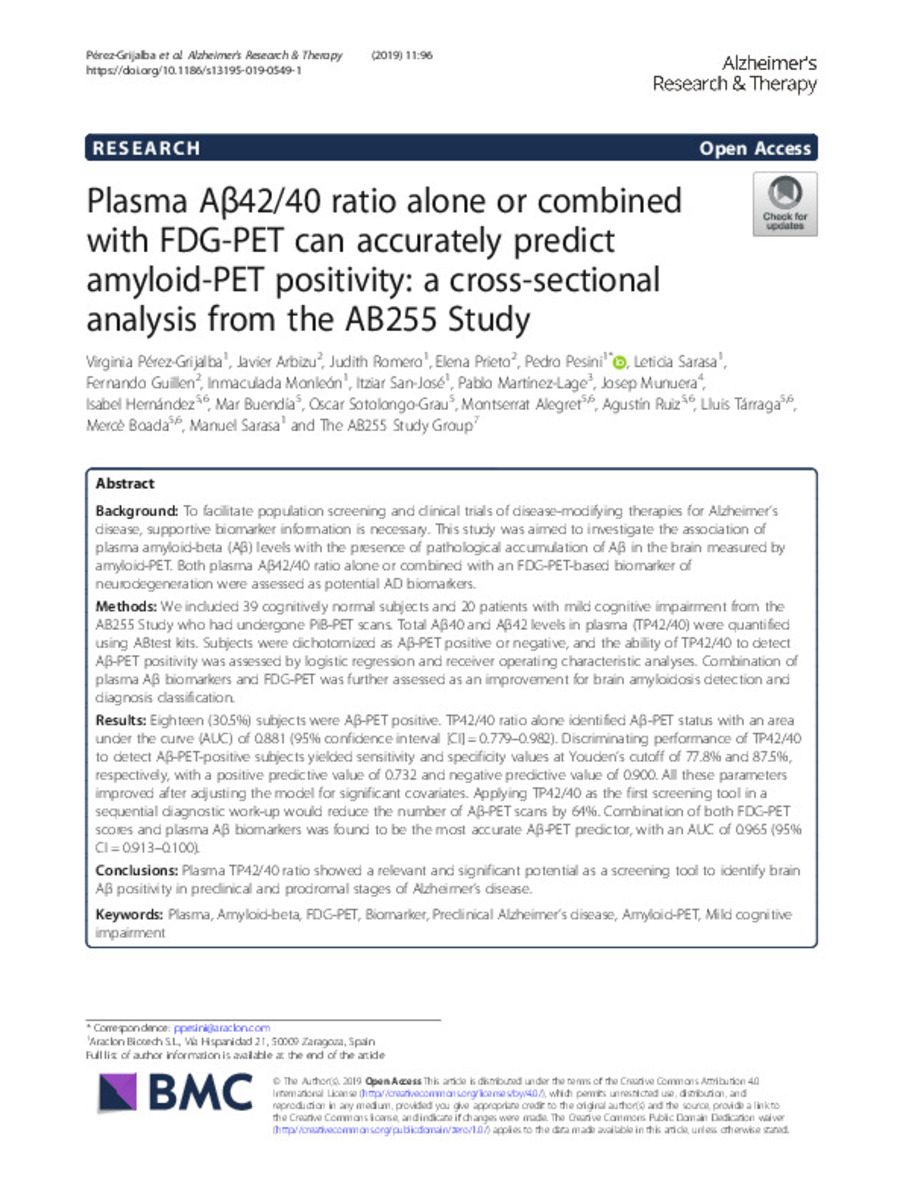Full metadata record
| DC Field | Value | Language |
|---|---|---|
| dc.creator | Pérez-Grijalba, V. (Virginia) | - |
| dc.creator | Arbizu, J. (Javier) | - |
| dc.creator | Romero, J. (Judith) | - |
| dc.creator | Prieto, E. (Elena) | - |
| dc.creator | Pesini, P. (Pedro) | - |
| dc.creator | Sarasa, L. (Leticia) | - |
| dc.creator | Guillen, F. (Fernando) | - |
| dc.creator | Monleón, I. (Inmaculada) | - |
| dc.creator | San-José, I. (Itziar) | - |
| dc.creator | Martinez-Lage, P. (Pablo) | - |
| dc.creator | Munuera, J. (Josep) | - |
| dc.creator | Hernandez, I. (I.) | - |
| dc.creator | Buendía, M. (Mar) | - |
| dc.creator | Sotolongo-Grau, O. (Oscar) | - |
| dc.creator | Alegret, M. (Montserrat) | - |
| dc.creator | Ruiz, A. (Agustín) | - |
| dc.creator | Tárraga, L. (Lluis) | - |
| dc.creator | Boada, M. (Mercè) | - |
| dc.creator | Sarasa, M. (Manuel) | - |
| dc.creator | The AB255 Study Group | - |
| dc.date.accessioned | 2022-03-22T08:17:33Z | - |
| dc.date.available | 2022-03-22T08:17:33Z | - |
| dc.date.issued | 2019 | - |
| dc.identifier.citation | Pérez-Grijalba, V. (Virginia); Arbizu, J. (Javier); Romero, J. (Judith); et al. "Plasma Aβ42/40 ratio alone or combined with FDG-PET can accurately predict amyloid-PET positivity: a cross-sectional analysis from the AB255 Study". Alzheimer's Research & Therapy. 11 (96), 2019, 2019 | es |
| dc.identifier.issn | 1758-9193 | - |
| dc.identifier.uri | https://hdl.handle.net/10171/63273 | - |
| dc.description.abstract | Background: To facilitate population screening and clinical trials of disease-modifying therapies for Alzheimer’s disease, supportive biomarker information is necessary. This study was aimed to investigate the association of plasma amyloid-beta (Aβ) levels with the presence of pathological accumulation of Aβ in the brain measured by amyloid-PET. Both plasma Aβ42/40 ratio alone or combined with an FDG-PET-based biomarker of neurodegeneration were assessed as potential AD biomarkers. Methods: We included 39 cognitively normal subjects and 20 patients with mild cognitive impairment from the AB255 Study who had undergone PiB-PET scans. Total Aβ40 and Aβ42 levels in plasma (TP42/40) were quantified using ABtest kits. Subjects were dichotomized as Aβ-PET positive or negative, and the ability of TP42/40 to detect Aβ-PET positivity was assessed by logistic regression and receiver operating characteristic analyses. Combination of plasma Aβ biomarkers and FDG-PET was further assessed as an improvement for brain amyloidosis detection and diagnosis classification. Results: Eighteen (30.5%) subjects were Aβ-PET positive. TP42/40 ratio alone identified Aβ-PET status with an area under the curve (AUC) of 0.881 (95% confidence interval [CI] = 0.779–0.982). Discriminating performance of TP42/40 to detect Aβ-PET-positive subjects yielded sensitivity and specificity values at Youden’s cutoff of 77.8% and 87.5%, respectively, with a positive predictive value of 0.732 and negative predictive value of 0.900. All these parameters improved after adjusting the model for significant covariates. Applying TP42/40 as the first screening tool in a sequential diagnostic work-up would reduce the number of Aβ-PET scans by 64%. Combination of both FDG-PET scores and plasma Aβ biomarkers was found to be the most accurate Aβ-PET predictor, with an AUC of 0.965 (95% CI = 0.913–0.100). Conclusions: Plasma TP42/40 ratio showed a relevant and significant potential as a screening tool to identify brain Aβ positivity in preclinical and prodromal stages of Alzheimer’s disease. | es_ES |
| dc.description.sponsorship | This work was funded by Araclon Biotech, Fundació ACE Memory Clinic, as well as the Spanish Ministry of Health through Instituto de Salud Carlos III (Madrid) (FISS PI10/00954) and by Agència d’Avaluació de Tecnologia i Recerca Mèdiques, Departament de Salut de la Generalitat de Catalunya (RECERCALIA grant 390/06/ 2009). Araclon Biotech was the main funder of the study, participating in conceptualization, design, data collection, and manuscript preparation. | es_ES |
| dc.language.iso | eng | es_ES |
| dc.publisher | Springer Science and Business Media LLC | es_ES |
| dc.rights | info:eu-repo/semantics/openAccess | es_ES |
| dc.subject | Plasma | es_ES |
| dc.subject | Amyloid-beta | es_ES |
| dc.subject | FDG-PET | es_ES |
| dc.subject | Biomarker | es_ES |
| dc.subject | Preclinical Alzheimer’s disease | es_ES |
| dc.subject | Amyloid-PET | es_ES |
| dc.subject | Mild cognitive impairment | es_ES |
| dc.title | Plasma Aβ42/40 ratio alone or combined with FDG-PET can accurately predict amyloid-PET positivity: a cross-sectional analysis from the AB255 Study | es_ES |
| dc.type | info:eu-repo/semantics/article | es_ES |
| dc.description.note | This article is distributed under the terms of the Creative Commons Attribution 4.0 International License (http://creativecommons.org/licenses/by/4.0/), which permits unrestricted use, distribution, and reproduction in any medium, provided you give appropriate credit to the original author(s) and the source, provide a link to the Creative Commons license, and indicate if changes were made. The Creative Commons Public Domain Dedication waiver (http://creativecommons.org/publicdomain/zero/1.0/) applies to the data made available in this article, unless otherwise stated. | es_ES |
| dc.identifier.doi | 10.1186/s13195-019-0549-1 | - |
| dadun.citation.number | 96 | es_ES |
| dadun.citation.publicationName | Alzheimer's Research & Therapy | es_ES |
| dadun.citation.startingPage | 2019 | es_ES |
| dadun.citation.volume | 11 | es_ES |
Files in This Item:
Statistics and impact
Items in Dadun are protected by copyright, with all rights reserved, unless otherwise indicated.






